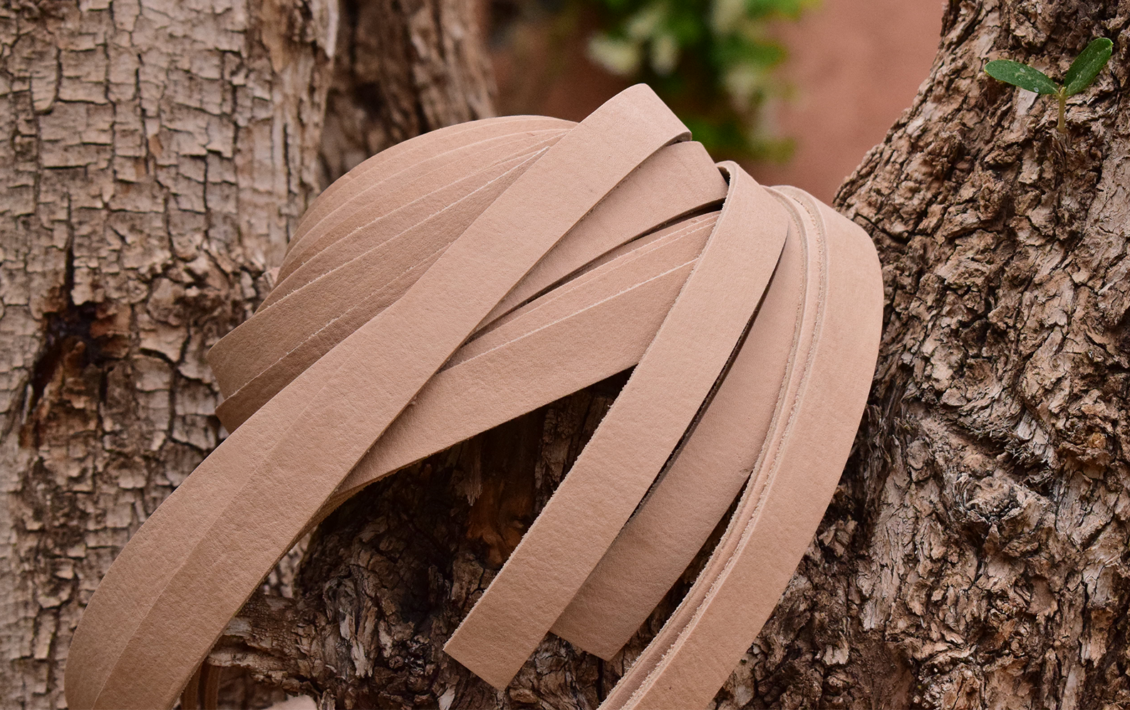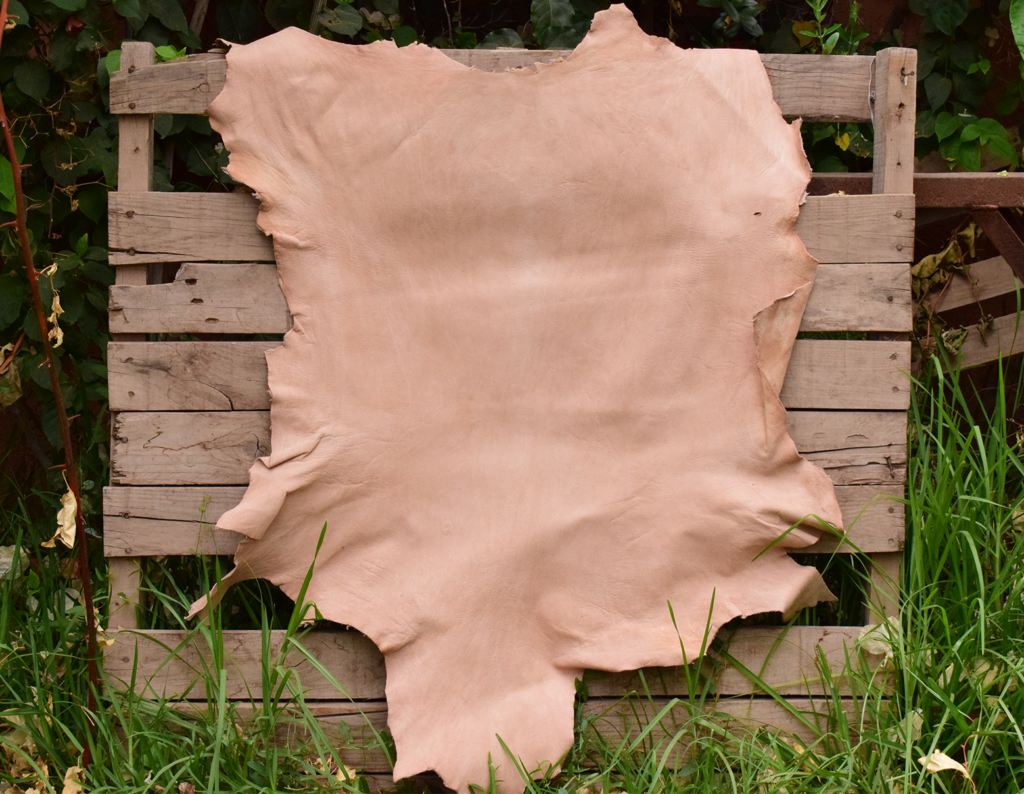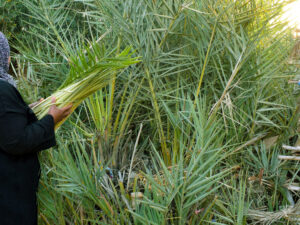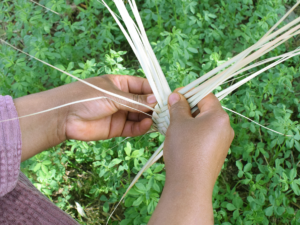
The art of leather
At the heart of our Moroccan craft workshop, leather occupies an honorable place in the manufacture of our baskets. This noble material, worked on with know-how and passion, is used for a wide variety of handicraft products, including our baskets. In this blog, we dive into the fascinating world of Moroccan leather and its innovative use in the art of basketry, our main activity.
Moroccan Leather
For centuries, Morocco has been known for the exceptional quality of its leather, a legacy of craftsmanship passed on from generation to generation. Tanners from Morocco are masters in the art of treating and dying leather, using traditional techniques dating back to antiquity. Moroccan leather is distinguished by its flexibility, durability, and rich color shades, making it a valued material worldwide.
The Use of Leather in basketry
While our traditional baskets were often carved out of natural materials such as oak, palm trees, and halfa, the use of leather in fermentation is a recent but promising development. Our craftsmen used the unique properties of leather to create stylish and functional baskets.
Manufacturing Techniques
Our craftsmen use various techniques to work the leather and turn it into baskets. Some baskets are made entirely from truncated leather, while others incorporate leather elements such as handles, edges, or ornaments. Leather can be truncated, sewn, dyed, embossed, and even stamped to create complex patterns and unique designs.
The manufacturing stages of leather handle follow a traditional process, where each step is carefully carried out by our experienced artisans.
Here is an overview of the main manufacturing steps:

1. Leather Selection: It all starts with the choice of leather. High-quality skins are selected, usually from cow or goat skins, depending on the strength and aesthetics desired for the donkeys.
2. Cut: Selected leather skins are cut into strips of the appropriate size for the ankles. Our craftsmen take care to cut the strips accurately, taking into account the desired length, width, and thickness for each handle.
3. Smoothing: Leather strips are then smoothed and leveled to eliminate imperfections and obtain a uniform surface. This step is essential to ensuring that the ankles will have a smooth and attractive appearance once they are finished.
4. Folding and modeling: Leather strips are folded according to the desired shape for the ankles, whether flat, rounded, or truncated. Our craftsmen often use templates to ensure uniform and consistent dimensions.
5. Sewing: Depending on the style and design of the handle, some may require seams to strengthen the folds or to add decorative elements. Our craftsmen use specialized sewing techniques, often by hand, to secure the different parts of the sash together.
6. Finishing: Once the cords are assembled, they are subjected to finishing stages to improve their appearance and durability. This can include smoothing edges, polishing the surface, and applying protective treatments to prevent wear and damage.
7. Inspection and Quality: Before being ready for use, leather handle are inspected to ensure that they meet high quality standards. Any defects or imperfections are corrected, guaranteeing that each handle is a product of artisanal quality.
Once all these steps are completed, leather handle are ready to be integrated into various products such as handbags, beach bags, backpacks, and more, adding a touch of elegance and durability to every craft creation.
The Versatility of Leather in the Moroccan basketry
Our Moroccan leather baskets are appreciated for their versatility and durability. They can be used as stylish shopping bags, as storage baskets in the house, or even as chic decoration accessories. Variations in styles and sizes are endless, allowing everyone to find the perfect leather basket to suit their needs and style.
Future Perspectives
As the world evolves, Moroccan craft continues to reinvent itself to meet the demands of the modern market. Craftsmen explore new techniques and designs to remain relevant while preserving the essence of their cultural heritage. In this context, leather remains a valuable and inspiring material that will continue to play an important role in the future of Moroccan basketry.

L’Art du Cuir
Au cœur de notre atelier d’artisanat marocains, le cuir occupe une place d’honneur dans la fabrication de nos paniers . Cette matière noble, travaillée avec savoir-faire et passion, est utilisée pour une grande variété de produits artisanaux, y compris nos paniers. Dans ce blog, nous plongeons dans l’univers fascinant du cuir marocain et son utilisation innovante dans l’art de la vannerie notre principale activité .
Le Cuir Marocain
Depuis des siècles, le Maroc est réputé pour la qualité exceptionnelle de son cuir, héritage d’un artisanat transmis de génération en génération. Les tanneurs du Maroc sont des maîtres dans l’art de traiter et de teindre le cuir, utilisant des techniques traditionnelles qui remontent à l’Antiquité. Les cuirs marocains se distinguent par leur souplesse, leur durabilité et leurs riches nuances de couleur, ce qui en fait des matériaux prisés dans le monde entier.
L’Utilisation du Cuir dans la Vannerie
Si nos paniers traditionnels étaient souvent tressés à partir de matériaux naturels tels que l’osier, le palmier et l’halfa, l’utilisation du cuir dans la vannerie est une évolution récente mais prometteuse. Nos artisans ont su tirer parti des propriétés uniques du cuir pour créer des paniers à la fois élégants et fonctionnels.
Techniques de Fabrication
Nos artisans utilisent diverses techniques pour travailler le cuir et le transformer en paniers. Certains paniers sont entièrement fabriqués à partir de cuir tressé, tandis que d’autres intègrent des éléments en cuir comme des poignées, des bordures ou des ornements. Le cuir peut être tressé, cousu, teint, embossé et même estampé pour créer des motifs complexes et des designs uniques.
Les étapes de fabrication des anses en cuir suivent un processus traditionnel, où chaque étape est réalisée avec soin par nos artisans expérimentés.
Voici un aperçu des principales étapes de fabrication :

1. Sélection du Cuir :
Tout commence par le choix du cuir. on sélectionnent des peaux de haute qualité, généralement du cuir de vache ou de chèvre, en fonction de la résistance et de l’esthétique souhaitées pour les anses.
2. Découpe :
Les peaux de cuir sélectionnées sont découpées en bandes de la taille appropriée pour les anses. nos artisans veillent à découper les bandes avec précision, en tenant compte de la longueur, de la largeur et de l’épaisseur désirées pour chaque anse.
3. Lissage :
Les bandes de cuir sont ensuite lissées et égalisées pour éliminer les imperfections et obtenir une surface uniforme. Cette étape est essentielle pour garantir que les anses auront une apparence lisse et attrayante une fois terminées.
4. Pliage et Modelage :
Les bandes de cuir sont pliées selon la forme souhaitée pour les anses, qu’il s’agisse de anses plates, arrondies ou tressées. Nos artisans utilisent souvent des gabarits pour garantir que les anses ont des dimensions uniformes et cohérentes.
5. Couture :
Selon le style et la conception des anses, certaines peuvent nécessiter des coutures pour renforcer les plis ou pour ajouter des éléments décoratifs. Nos artisans utilisent des techniques de couture spécialisées, souvent à la main, pour fixer les différentes parties de l’anse ensemble de manière sécurisée.
6. Finition :
Une fois les anses assemblées, elles sont soumises à des étapes de finition pour améliorer leur apparence et leur durabilité. Cela peut inclure le lissage des bords, le polissage de la surface et l’application de traitements de protection pour prévenir l’usure et les dommages.
7. Inspection et Qualité :
Avant d’être prêtes à être utilisées, les anses en cuir sont inspectées pour s’assurer qu’elles répondent aux normes de qualité élevées. Tout défaut ou imperfection est corrigé, garantissant que chaque anse est un produit de qualité artisanale.
Une fois toutes ces étapes terminées, les anses en cuir sont prêtes à être intégrées dans divers produits tels que des sacs à main, des sacs de plage, des sacs à dos et bien d’autres encore, ajoutant une touche d’élégance et de durabilité à chaque création artisanale.
La Polyvalence du Cuir dans la Vannerie Marocaine
nos paniers en cuir marocains sont appréciés pour leur polyvalence et leur durabilité. Ils peuvent être utilisés comme sacs de courses élégants, comme corbeilles de rangement dans la maison, ou même comme accessoires de décoration chic. Les variations de styles et de tailles sont infinies, permettant à chacun de trouver le panier en cuir parfait pour répondre à ses besoins et à son style.
Perspectives d’Avenir
Alors que le monde évolue, l’artisanat marocain continue de se réinventer pour répondre aux demandes du marché moderne. Les artisans explorent de nouvelles techniques et de nouveaux designs pour rester pertinents tout en préservant l’essence de leur héritage culturel. Dans ce contexte, le cuir reste un matériau précieux et inspirant qui continuera à jouer un rôle important dans l’avenir de la vannerie marocaine.





Leave a Reply